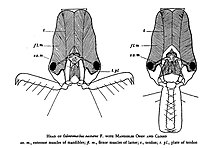Snapjaw ants
| Snapjaw ants | ||||||||||
|---|---|---|---|---|---|---|---|---|---|---|

Ant of the genus Odontomachus |
||||||||||
| Systematics | ||||||||||
|
||||||||||
| Scientific name | ||||||||||
| Odontomachus | ||||||||||
| Latreille , 1804 |
The snapping jaw ants ( Odontomachus ) are a genus of ants (Formicidae) from the subfamily of the primeval ants (Ponerinae).
features
The ants are characterized by strongly pronounced mandibles . The mandibles are straight, barely curved, and have only two or three teeth at the tip. In contrast to other ancient ants, there is no typical constriction between the first and second gaster segment . The petiolar stigma is formed into an upward pointing tip. The forehead groove is pronounced and often very deep.
Construction of the mandibles
The animals have a quick snap mechanism. This is based on the fact that the necessary energy is previously stored elastically in a strong sphincter located in the head like an arch. The jaw is blocked in this open position. The mandibles only have the opportunity to snap together when the jaw is disengaged by another muscle. When the mechanism is triggered, the upper jaw of O. bauri develops a force that is 300 times the weight of the ant's body . The movement of the snapping jaws is the fastest measured in the animal kingdom at 64 meters per second. The insect only needs 0.13 milliseconds to snap the mouthparts shut.
Function of snapping
The snapping jaw ants use their mandibles for prey as well as for defense and flight. The quick snap action is used as a jump mechanism. To protect themselves against intruders like other ants, the ants perform a long jump of up to 40 cm, on average 22 cm. In front of this, the opponent is first attacked with the mandibles. The insect then catapults itself away from the intruder, which is also thrown backwards. During the jump it can happen that the ant makes several somersaults .
Similar genera
Odontomachus are very similar to the closely related Anochetus . However, these are smaller and have the guest constriction typical of ancient ants. In addition, in Anochetus the stem member is rounded at the top and sometimes has two thorns, but is never formed into a single point. The snap- jaw mechanisms of the genera Anochetus , Odontomachus (both subfamily Ponerinae), Myrmoteras (subfamily Formicinae ), Strumigenys and Daceton (both subfamily Myrmicinae ) are the result of convergent evolution.
distribution
These ants are common in tropical and subtropical areas around the world. 65 different types are known.
Way of life
The workers hunt in isolation both during the day and at night. They mainly prey on small arthropods on the surface of the earth or on trees, using their mandibles as weapons. The underground nests are preferably created in the open field, but also in the protection of stones and rocks. Sometimes lying dead wood is also colonized.
Systematics
The following species belong to the genus Odontomachus (selection):
- Odontomachus bauri Emery, 1892
- Odontomachus brunneus Patton, 1894
- Odontomachus clarus Roger, 1861
- Odontomachus haematodus Linnaeus , 1758 (syn. O. haematoda ) (type species)
- Odontomachus hastatus Fabricius , 1804
- Odontomachus insularis Guérin-Méneville, 1844
- † Odontomachus paleomyagra Wappler, Dlussky, Engel, Prokop & Knor, 2014
- Odontomachus ruginodis Smith, 1937
Synonyms
The following names are synonyms for the genus Odontomachus :
- Champsomyrmex Emery, 1891
- Myrtoteras Matsumura, 1912
- Pedetes Bernstein, 1861
swell
literature
- Bert Hölldobler , Edward O. Wilson : Ants. The discovery of a fascinating world. Birkhäuser Verlag, Basel - Boston - Berlin 1995, ISBN 3-7643-5152-7
Individual evidence
- ↑ a b c Genus Odontomachus. Australian Ants Online, archived from the original on December 6, 2008 ; Retrieved July 20, 2013 .
- ↑ a b Multifunctionality and mechanical origins: Ballistic jaw propulsion in trap-jaw ants. Proceedings of the National Academy of Sciences, accessed June 5, 2008 .
- ↑ Martin Vieweg: Whimsical snap mechanism decoded. From: Wissenschaft.de from August 31, 2017, accessed on September 9, 2019.
- ↑ Odontomachus Taxon Count. (No longer available online.) Hymenoptera Name Server, formerly the original ; Retrieved June 4, 2008 . ( Page no longer available , search in web archives )
- ↑ An Online Catalog of the Ants of the World: O. paleomyagra
- ↑ Hölldobler and Wilson : The Ants . Springer (1990) ISBN 3-540-52092-9
Web links
- AntWeb pictures of different Odontomachus species



